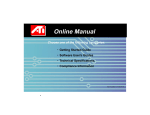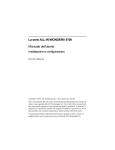Download ATI Technologies Workstation x1000 User`s guide
Transcript
FireGL™ X2-256t FireGL™ X2-256 FireGL™ X1-128 FireGL™ Z1-128 User’s Guide P/N: 137-50015-40 © Copyright 2004, by ATI Technologies Inc. All rights reserved. Reproduction of this manual, or parts thereof, in any form, without the express written permission of ATI Technologies Inc. is strictly prohibited. ATI and all ATI product and product feature names are trademarks and/or registered trademarks of ATI Technologies Inc. All other company and/or product names are trademarks and/or registered trademarks of their respective owners. Features, performance and specifications are subject to change without notice. Product may not be exactly as shown in the diagrams. FireGL, FIRE GL, HYDRAVISION – ATI Technologies Inc.; Athlon – Advanced Micro Devices. Inc.; Fire Wire – Apple Computer Inc.; Direct3D, Windows 2000, Windows XP – Microsoft Corp.; IEEE – The Institute of Electrical and Electronic Engineers, Inc.; AGP (Accelerated Graphics Port), Celeron, Pentium Pro, Pentium II, Pentium III – Intel Corporation; VGA – International Business Machines Corp.; OpenGL - Silicon Graphics Inc.; VESA – Video Electronics Standards Association. Adobe and Acrobat are trademarks of Adobe Systems Incorporated, which may be registered in certain jurisdictions. i Disclaimer While every precaution has been taken in the preparation of this document, ATI Technologies Inc. assumes no liability with respect to the operation or use of ATI hardware, software or other products and documentation described herein, for any act or omission of ATI concerning such products or this documentation, for any interruption of service, loss or interruption of business, loss of anticipatory profits, or for punitive, incidental or consequential damages in connection with the furnishing, performance, or use of the ATI hardware, software, or other products and documentation provided herein. ATI Technologies Inc. reserves the right to make changes without further notice to a product or system described herein to improve reliability, function or design. With respect to ATI products which this document relates, ATI disclaims all express or implied warranties regarding such products, including but not limited to, the implied warranties of merchantability, fitness for a particular purpose, and noninfringement. Documentation updates ATI is constantly improving its product and associated documentation. To maximize the value of your ATI product, you should ensure that you have the latest documentation. ATI’s documentation contains helpful installation/configuration tips and other valuable feature information. ii Contents Getting Started............................................................... 1 Using this Guide ............................................................................................ 2 Viewing the User's Guide Online........................................................... 3 Do you Need a Printout of the Online User's Guide?............................. 3 Customer Care ............................................................................................... 4 FireGL Card Features ........................................................................... 5 System Requirements and Tools ................................................................... 7 Quick Installation .......................................................................................... 8 Installing the Hardware and Software ......................... 9 Installing the Hardware ................................................................................. 9 Preparing your Computer ..................................................................... 10 Installing the Card ................................................................................ 14 Connecting the Cables and Completing the Installation ...................... 20 Installing the Software................................................................................. 23 Before you Start: Information, Tips, and Hints.................................... 24 Software Installation for Windows 2000 and Windows XP ................ 25 Using Your FireGL Card.............................................. 27 Using Two Monitors.................................................................................... 29 Using the DualScreen Tab .................................................................. 30 Changing the Video Settings ....................................................................... 31 How to Switch to the Display Properties ............................................. 31 Setting Resolution, Color Depth and Refresh Rate............................. 31 Adjusting the Monitor Display............................................................. 33 Using Application Profiles and Advanced Functions.................................. 36 Configuring Application Profiles ......................................................... 36 Setting Advanced Functions................................................................. 39 see also HYDRAVISION™ User’s Guide iii Reference ..................................................................... 41 Removing the FireGL Drivers..................................................................... 41 Troubleshooting........................................................................................... 43 Technical Details ......................................................................................... 46 Product Specifications.......................................................................... 46 Pin Assignments ................................................................................... 48 Video Modes ........................................................................................ 49 Warranty Service Information ..................................................................... 51 Compliance Information.............................................................................. 53 iv 1 CHAPTER 1 Getting Started Your ATI FireGL card is an advanced workstation 3D graphics accelerator based on a high-bandwidth, parallel pipeline geometry and rendering architecture. The card delivers workstation-class performance to designers, engineers and animators, running the leading OpenGL and DirectX applications Features of your FireGL workstation graphics accelerator: • Real-time photo-realistic rendering and animation • Stable and reliable software support for Windows® and Linux® platforms • Optimized support for the leading workstation applications • SMARTSHADER™ technology for creating complex visual effects • SMOOTHVISION™ technology for advanced full-scene anti-aliasing IN THIS CHAPTER... ■ Using this Guide on page 2 ■ FireGL Card Features on page 5 ■ System Requirements and Tools on page 7 ■ Quick Installation on page 8 2 Getting Started Using this Guide Many hyperlinks provide easy access to any information you may want. To make it useful in a printed format, too, a hyperlinked - table of contents and page numbers are provided. Since this guide was designed to be used online and printed, the quality of some images on screen or in print may be affected. The organization of this guide is as follows: Installing the Hardware and Software on page 9 provides instructions for installing your FireGL card, loading the driver and connecting video output devices to your card. Using Your FireGL Card on page 27 explains how you can take advantage of the advanced features of your FireGL card. Reference on page 41 provides troubleshooting tips and regulatory compliance information for your card. HYDRAVISION™ User’s Guide provides information on using HYDRAVISION, a multi-monitor and desktop management utility to control multiple display desktops. Getting Started 3 Viewing the User's Guide Online You can easily read the User's Guide online - important hypertext links, such as Table of Contents entries, World Wide Web, and E-mail addresses are active. Place your mouse cursor over Table of Contents entries or main headings. If the hand icon changes to a pointing index finger, simply click and you will move to that place in the document. Displaying the provided bookmark and thumbnail views may help you with the navigation in the User's Guide. Some E-mail or Web addresses inside this manual may be active as well. Go directly to a Web, FTP site, or E-mail program simply by clicking on an active link. This manual might be displayed with slightly-reduced magnification in your Reader. If you experience any difficulty reading certain files online, use the Reader's Zoom To feature from the View menu and increase the magnification to about 150%. To view details of some screenshot images you may need to increase magnification. Do you Need a Printout of the Online User's Guide? You can also print this User's Guide to access it off-line. The manual then will look like any standard document with a table of contents and page numbers. For printing the User's Guide, a print resolution of 600 dpi or higher is recommended. 4 Getting Started Customer Care If you require assistance to get the most out of your product, the following options are available: • Online: For product information, video drivers, Frequently Asked Questions and Email support visit: http://www.ati.com and select CUSTOMER CARE. • FireGL Workstation dedicated toll free support line: *866-284-2093 Available Monday through Friday, 9:00 AM - 7:00 PM EST. *Access to Telephone Support is available to workstation users at no additional cost. For complete details please visit: http://www.ati.com/support/contact.html • Mail: ATI Technologies Inc. Attention: Customer Service 1 Commerce Valley Drive East Markham, Ontario Canada L3T 7X6 ATI Customer Care Product Online Registration By registering your ATI product you will be able take advantage of driver update notification, technical updates, online store specials and promotions, contests / giveaway announcements and information specific to your product. Product Online Registration is available at: http://www.ati.com/online/registration Getting Started FireGL Card Features FireGL X2-256t pictured FireGL VPU Video Memory Rendering Pipelines FireGL X2-256t FGL 9800XT 256 MB 8 FireGL X2-256 FGL 9800 256 MB 8 FireGL X1-128 FGL 9700 128 MB 8 FireGL Z1-128 FGL 9500 128 MB 4 VPU: Visual Processing Unit • Video memory: DDR SDRAM - unified frame buffer, Z-buffer, texture storage - 128-bit floating point precision frame buffer for photo-realistic renderings. - 256-bit memory interface for fast 3D graphics • Pixel pipeline architecture provides enhanced rendering power. 5 6 Getting Started • Supports AGP 3.0 standard (AGP 4X/8X), providing a two way high-speed interface between the graphics subsystem and the workstation • OpenGL 1.3 with 1.4 extensions DirectX® 9.0 functionality in OpenGL® • Full DirectX® 9.0 support • DDC1/2b/2b+ monitor support on all operating system platforms • Support for two analog or digital monitors High resolutions up to 2048 x 1536, 32-bit Independent resolutions and refresh rates for any two connected monitors 9.1 Mpixel, 3840 x 1240 single-display support • Application-specific display profile utilities for optimal performance • Intel Pentium® 4 Streaming SIMD and AMD Athlon 3Dnow!™ support for Windows 2000, Windows XP and Linux operating systems. i For more detailed information on features and performance please refer to the section Technical Details on page 46. Getting Started System Requirements and Tools Computer system • • • Operating system • CD-ROM drive • Windows® 2000 with Service Pack 1 (or higher) Windows® XP Linux XFree86 4.X.0 • • Service Pack Information for Windows 2000 Intel® Pentium® 3, Pentium® 4, Xeon® AMD® Athlon® XP/MP/Opteron or compatible 128 MB of system memory 256 MB or more for best performance Motherboard with free AGP slot and correct AGP chipset-driver You must be running Windows 2000, updated with Service Pack 1 (or higher) prior to installing the FireGL drivers. Service Packs are available from Microsoft's web site, www.microsoft.com. Tools • • Monitor • • A screwdriver to remove and reinstall the PC cover screws and card mounting screws. See your PC manual for specific requirements. ATI INSTALLATION CD-ROM for your FireGL card High-resolution MultiSync or multi-frequency monitors or other VGA monitors. Digital flat-panel (DFP) displays or digital CRT displays 7 8 Getting Started Quick Installation • Brief instructions on how to get to work with the FireGL card in the shortest possible time. • Recommended for experienced users and system administrators only. • For more detailed information on installation and operation of your graphics accelerator, please refer to Chapter 2 and Chapter 3. Installation Steps 1 If you are replacing an existing graphics card, un-install the drivers and software for your old graphics card. 2 Disable any on-board graphics solution on the motherboard. 3 4 5 6 7 Shut down and disconnect your computer system. Remove the installed (AGP or PCI) graphics card. Install the new FireGL card. Reassemble and connect your computer system. Install the FireGL drivers and configuration software from the ATI INSTALLATION CD-ROM: - automatic ATISETUP utility or - Start > Run > X:\ATISETUP.EXE where X is the drive letter of your CD-ROM drive 9 CHAPTER 2 Installing the Hardware and Software IN THIS CHAPTER... ■ Installing the Hardware on page 9 ■ Installing the Software on page 23 Installing the Hardware The hardware installation includes the following steps: • Preparing your Computer • Installing the Card • Connecting the Cables and Completing the Installation 10 Installing the Hardware and Software Preparing your Computer Information Before you Start Do This First! Install the latest AGP chipset driver for your motherboard. • Each motherboard requires the installation of a custom-built virtual GART (AGP) driver. This chipset driver is required by your FireGL card to function correctly with your motherboard. • You must install the correct AGP chipset driver before installing the FireGL card in your system. • Contact your supplier or motherboard/chipset manufacturer to obtain and install the latest AGP chipset driver for your motherboard. An incorrect or missing chipset driver can result in AGP memory not being detected or a black screen after Windows® starts. How to determine what motherboard chipset is present on your system • • • • • Right-click My Computer and select Properties. Click the Hardware tab and select Device Manager. Scroll to the bottom of the device list. Select System devices. Scroll through the list of System devices until you find a listing for the AGP controller. The chipset manufacturer’s name will appear as the device name. Installing the Hardware and Software 11 Turn off the power to your system and discharge your body's static electric charge by touching a grounded surface (for example, the metal surface of the power supply) before performing any hardware procedure. The manufacturer assumes no liability for any damage, caused directly or indirectly, by improper installation of any components by unauthorized service personnel. If you do not feel comfortable performing the installation, consult a qualified computer technician. Damage to system components, the accelerator card, and injury to yourself may result if power is applied during installation. What do you need to use your FireGL card? System Requirements and Tools • Motherboard with free AGP 8x/4x slot: • Correct AGP GART chipset driver installed for your motherboard. • 128 MB of system memory 256 MB or more for best performance • System interrupt (IRQ) which is free. This may have to be reserved in the computer's BIOS. For help with this subject, refer to the manual for your mainboard • Intel® Pentium® 3, Pentium® 4, Xeon®; AMD® Athlon® XP/MP, or compatible • Supported operating system - Windows® 2000 with Service Pack 1 (or higher) - Windows® XP - Linux XFree86 4.X.0 • A screwdriver to remove and reinstall the PC cover screws and card mounting screws. See your PC manual for specific requirements. • ATI INSTALLATION CD-ROM for your FireGL card. 12 Installing the Hardware and Software What monitors do you need? Your FireGL card is configured to be combined with digital flat-panel (DFP) displays and digital CRT displays. Note: Your DFP monitor must have a data cable with digital-only DVI plug (DVI-D) - but not with integrated analog/digital DVI plug (DVI-I). Check with your monitor's documentation. You can also connect the FireGL card to highresolution MultiSync or multi-frequency monitors or other VGA monitors. Notes: (1) You need a Plug-and-Play monitor that supports VESA's Display Channel specifications (DDC1 or DDC2) to take advantage of the DDC1/DDC2b+ features (2) You can use the full power of the graphics card only if your monitor supports the horizontal (kHz) and vertical (Hz) refresh rates as required by the graphics card. Refer to your monitor's documentation for recommended refresh rates Where are the drivers? • • Are you planning a multi-monitor system? • • • Windows 2000 and Windows XP drivers are provided on the ATI INSTALLATION CD-ROM. The most recent certified drivers are available from www.ati.com/FireGL. Linux drivers and installation instructions are available for downloading from www.ati.com/support. You may connect two monitors to the FireGL™ card. If DDC support is available, the respective resolution and refresh rate for each monitor is automatically detected. The following multi-monitor and Desktop Management utilities are provided: - HYDRAVISION™ - DualScreen Installing the Hardware and Software 13 Replacing an existing graphics card Before you install your FireGL card, we recommend that you first uninstall the driver for your current graphics card. Replacing integrated graphics Please refer to the manual or contact your motherboard manufacturer to determine how to disable your on-board graphics. Illustrations The illustrations provided in this section are for instructional use only; the card shown may look different than the one you purchased. i Note the serial number and the part number of your FireGL card before installing it in your computer. You need these numbers for the product warranty registration. You will find the numbers on the product label on the back of your FireGL card. 14 Installing the Hardware and Software Installing the Card To install your graphics accelerator card, follow these steps: 1 Switch off your computer and all external options (monitor, printer, and others). Then disconnect all cables from the back of your computer. Unplug all power cables from the electrical source. Note: If you are disconnecting a peripheral from the computer or are removing a component from the system board, wait 10 - 20 seconds after disconnecting the computer from the electrical outlet before disconnecting the peripheral or removing the component to avoid possible damage to the system board. To verify that all power has been disconnected from the system, make sure that the standby power light-emitting diode (LED) on the system board has gone out. Installing the Hardware and Software 2 Remove the computer cover. If necessary, consult your computer system manual about removing the cover. 1 Power Supply. Remember to discharge your body's static electricity by touching the power supply or the metal surface of the computer chassis. 15 16 Installing the Hardware and Software 3 Remove any existing graphics card from your computer. • • • 4 Unscrew the screw attached to your existing graphics card. Then pull the card straight out. If the old graphics card sticks rock it gently from end to end. Remember to save the screw. If your computer has any on-board graphics capability, you may need to disable it on the motherboard. Refer to your computer's manual for more information. Connecting power to the card The FireGL™ card requires connection to your PC’s internal power supply for operation. A 300W power supply or greater is recommeded to ensure normal operation where a number of other internal devices are installed. Use the supplied Power Extension Cable to connect the FireGL™ card to the computer’s hard drive power connector. 1 Remove the power cable from the hard drive power connector. 2 Connect A of the Power Extension Cable to the FireGL card as shown. (the cable may already be connected to the graphics card.) 3 Connect B to the power supply connector Installing the Hardware and Software 4 Connect C to the hard drive power connector. . A Connector to FireGL card B Connector to computer power supply C Connector to hard drive power connector. 17 18 Installing the Hardware and Software 5 Insert the card into the AGP slot. Note: The FireGL card fits in either AGP 8x or AGP 4x slots. • Locate the AGP slot. Refer to your computer's manual for more information. • If necessary, remove the metal slot cover from the AGP slot. Save the screw to secure the graphics card later. • Align the FireGL card with the AGP slot, and press it in firmly until fully seated. 1 2 FireGL card AGP expansion slot AGP cards are designed to fit one way only. Be sure your card is properly aligned. Grasp the card by the top edge and carefully seat it into the AGP slot. Be sure the metal contacts are completely pushed into the slot. Installing the Hardware and Software 6 Replace the screw to fasten the card in place. • • 7 Align the slot in the mounting bracket of the card with the screw holes in the rear panel of the computer case. Use the screw you removed from the expansion slot cover or a previously installed graphics card to secure the card in place. Reassemble your computer. • Secure ribbon cables and gently push them down and out of the way before you replace the system cover. • Replace the computer cover. • Reconnect any peripheral equipment cables you may have disconnected. 19 20 Installing the Hardware and Software Connecting the Cables and Completing the Installation Connecting the Monitor Cables You may connect one or two monitors, either DFP/digital CRT or analog VGA to the FireGL™ card. Use the provided DVI-toVGA adapters to connect monitors with a VGA connector. i If you connect only one monitor, make sure to connect it to DVI connector (1) on the card. Securely attach the data cable of your first monitor to the DVI output connector (1) on the card. Attach the cable to the monitor according to the monitor's instructions. Refer to the documentation that came with your monitor if you need additional installation information. Connect the data cable of your second monitor to the DVI output connector (2) on the card. FireGL X2-256, FireGL X1-128, FireGL Z1-128 FireGL X2-256t Installing the Hardware and Software 21 Connecting analog VGA Monitors to DVI connectors If the data cable connector on your VGA monitor does not fit into the DVI connector on the card, use the DVI-to-VGA adapters provided with your FireGL card.. a Monitor cable c b DVI connector on card d VGA connector from monitor DVI-to-VGA adapter Setting the Monitor Impedance If you can switch the impedance values on your monitor, use the following recommended settings: • RGB video input: 75 Ohm • Sync: 2.2 kOhm Try other 'Sync' settings if you cannot achieve a stable video image. If the impedance setting options are 'High' and 'Low' only, try the setting that provides the most satisfactory monitor display. 22 Installing the Hardware and Software Start your System Turn on your monitor before you turn on your computer. Failing to do so could damage your monitor. If you have correctly installed the card, operating system messages will appear on your monitor when the boot procedure is finished. i Your monitor is running in a basic video mode. Higher refresh rates are not available at this stage of the installation. After you have successfully installed the FireGL drivers you can use the tabs in the Display Properties menu to adjust the video settings and set up a multi-monitor configuration. If Your System Does Not Start as it Should • Verify that the installation instructions were properly followed. • Check that the card is properly installed in your system and connected to your monitor. • Refer to the documentation that came with your monitor: Check your connections to the video and power cables. Try adjusting the brightness, sharpness, and contrast controls of your monitor. • If you have problems during start-up, restart your computer in Safe Mode. While starting Windows® 2000 and Windows® XP, press and hold F8 until you see the Windows® Advanced Options Menu. Use the arrow keys to select Safe Mode, and press Enter. • Check the system configuration utility of your operating system for the interrupt assignments. • Please refer to the Troubleshooting section for more information, if it appears that the card is not performing optimally. • Contact ATI’s Customer Care or your local technical support. Installing the Hardware and Software 23 Installing the Software • Before you Start: Information, Tips, and Hints • Software Installation for Windows 2000 and Windows XP You will need to install the FireGL drivers and software in the following cases: • After you have installed the card in your system. • After you have re-installed or upgraded your operating system. (1) To install or remove the FireGL drivers, you need administrator rights or you must be logged on as a user with administrator rights under Windows 2000 and Windows XP. i (2) Information for Windows 2000: You must have Microsoft Windows Service Pack 1 (or higher) installed prior to installing the FireGL drivers. The Service Pack is available from Microsoft’s web site, www.microsoft.com. (3) Linux drivers and installation instructions are available for downloading from www.ati.com/support. (4) The most recent certified FireGL drivers are available from www.ati.com/FireGL 24 Installing the Hardware and Software Before you Start: Information, Tips, and Hints Before you install the drivers for your FireGL card, make sure your monitor cable is properly attached to the card. Do you need a special driver installation? The software installation procedure later in this chapter describes how to install the drivers for your graphics card after you have installed the new card for the first time and have rebooted your computer. This section offers some additional tips if you want or need to install the graphics card drivers in a special working scenario, for example, if you have re-installed your operating system, or if you want to perform a manual installation. • You can always install the drivers using the ATISETUP utility on the ATI INSTALLATION CD-ROM. The ATISETUP utility will start automatically, if you insert the ATI INSTALLATION CD-ROM into your CD-ROM drive after the operating system has started. If your CD-ROM auto-run is not enabled and/or the ATISETUP utility does not start automatically: Click the Start button in the task bar, click Run, and then select ATISETUP.EXE from the root directory of the ATI INSTALLATION CD-ROM. Click OK. • Where are the drivers? When prompted for a driver installation CD, insert the ATI INSTALLATION CD-ROM and enter or browse to \drivers. • You need your operating system installed and running before you can install the FireGL drivers. Installing the Hardware and Software 25 HYDRAVISION™ Multi-monitor Management The HYDRAVISION™ multi-monitor and desktop management software will install automatically with the Express driver installation of the ATISETUP utility. If you do not want to install HYDRAVISION™ select the Custom driver installation and clear the HYDRAVISION™ check box. Driver installation dialog The installation dialog will display in English if your operating system’s language is not supported. Software Installation for Windows 2000 and Windows XP 1 Start your system. When the Found New Hardware Wizard comes up, click Cancel. When the System Settings Change window asks you to restart your computer, click No. 2 Run the ATISETUP utility. The ATISETUP utility will start automatically, if you insert the ATI INSTALLATION CD-ROM into your CD-ROM drive after the operating system has started. If your CD-ROM auto-run is not enabled and/or the ATISETUP utility does not start automatically: Click the Start button in the task bar, click Run, and then select ATISETUP.EXE from the root directory of the ATI INSTALLATION CD-ROM. Click OK. 3 4 5 6 Click Install under Software Install. Click Next. Click Yes to the license agreement. ATI Easy Install starts the Installation Wizard. 26 Installing the Hardware and Software 7 Follow the Wizard’s on-screen instructions to complete the installation. The Express installation option is recommended. The HYDRAVISION™ multi-monitor and desktop management software will automatically be installed, along with the ATI driver, by selecting this option. Not all software components are installed using the Express installation. Custom installation allows you to select individual software components for installation. 8 When the Setup complete message appears, select Yes, I want to restart my computer now and click Finish. 9 After Windows 2000/Windows XP reboots, the Found New Hardware message may display the Digital Signature Not Found message. Click Yes or Continue to complete the driver installation. 10 Click Start > Settings > Control Panel > Display > Settings, or right-click on the Windows desktop, select Properties and Settings. 11 Set the resolution (Screen area), and color depth that best suit your requirements and your monitor’s performance. 12 Click the Advanced button and select the Monitor tab. 13 Set the refresh rate for the monitor connected to the FireGL card in your system. 14 Click OK until you are on the Windows desktop. i Refer to your Windows online help and documentation for further information on using the Monitor and Settings tabs. 27 CHAPTER 3 Using Your FireGL Card IN THIS CHAPTER... ■ Using Two Monitors on page 29 ■ Changing the Video Settings on page 31 ■ Using Application Profiles and Advanced Functions on page 36 As part of its Windows drivers, FireGL installs additional tabs to your Display Properties control panel. They are named as follows. Information Adjustment DualScreen Configuration Advanced Settings The Information tab displays card-specific hardware and driver information. This information may be helpful when contacting Tech Support. Click Display Properties > Settings > Advanced > Information. Use the Adjustment tab to adjust the display of the connected monitor(s) 28 Using Your FireGL Card Use the DualScreen tab to enable the following functions: • duplicate the display of the primary monitor on the second monitor • special video mode for high-resolution monitors Use the Configuration tab to customize application profiles for individual application settings. Use the Advanced Settings tab to enable the following functions: • SMOOTHVISION™ for enhanced image quality • Additional operation modes for DVI monitors Using Your FireGL Card 29 Using Two Monitors You can set resolutions, refresh rates, and display adjustment independently for any two connected displays. i For two-monitor configuration settings you need the following: • Two monitors connected to the card • Both monitors switched on when you start your computer • Use the Display Properties > Settings tab for the basic two-monitor configuration settings. Refer to your Windows online help and documentation for further information on using the Display Properties > Settings tab. • Switching to a two-monitor display: In the Display Properties > Settings tab click the monitor icon 2. Select Extend my Windows desktop onto this monitor. Set Screen resolution and Color quality for the second monitor. Click the Apply or OK button to enable your settings. • HYDRAVISION™ multi-monitor and desktop management software enables you to tailor your two-monitor desktop to the way you work. For more information on HYDRAVISION™, refer to the HYDRAVISION™ User’s Guide located on your ATI INSTALLATION CD-ROM. • If you want the display of the primary monitor duplicated on the second monitor, select Clone Mode in the DualScreen tab. i Options and settings in the Monitor and Adjustment tabs apply only to the monitor selected in the Display Properties > Settings tab. Click the corresponding monitor icon before you click Advanced. 30 Using Your FireGL Card Using the DualScreen Tab i To see the DualScreen tab displayed, you need the following: • Two monitors connected to the card • Both monitors switched on when you start your computer 1 Select the DualScreen tab via Display Properties > Settings > Advanced > DualScreen. Refer to the context sensitive online help for more information on setting up your DualScreen configuration. 2 Select High Resolution Mode to extend the display of a high-resolution monitor to the full size of the monitor. Note: The option High Resolution Mode is active only with a high-resolution monitor (9-million pixel class) connected. Using Your FireGL Card 31 3 Select Clone Mode if you want the display of the primary monitor duplicated on the second monitor. 4 Click the Apply or OK button to enable your DualScreen setting. Changing the Video Settings The tabs in the Display Properties menu allow setting and adjusting the video settings to best suit your specific requirements • Setting Resolution, Color Depth and Refresh Rate • Adjusting the Monitor Display How to Switch to the Display Properties 1 Start Windows. 2 Windows 2000: Click Start > Settings > Control Panel. Windows XP: Click Start > Control Panel > Appearance and Themes. 3 Double-click the Display icon. The Display Properties window appears. 1 You can also display the Display Properties window by right-clicking the Windows Desktop background and then selecting the Properties option from the pop-up menu. 2 Click the Advanced button in the Settings tab to gain access to the Monitor, Information, Configuration, Adjustment, DualScreen, and Advanced Settings tabs. i Setting Resolution, Color Depth and Refresh Rate 1 Select the Settings tab in the Display Properties window. 2 Color depth: Select a value from the Colors box. 3 Resolution: In the Screen area drag the slider. 32 Using Your FireGL Card 4 Refresh Rate: Select the Monitor tab via Display Properties > Settings > Advanced > Monitor. Select a refresh rate from the Refresh Frequency list (Screen refresh rates in Windows XP.) 5 6 7 8 Click Apply To preview the new settings, click OK. To accept the settings, click Yes; otherwise, click No. If the display becomes garbled or unusable, simply wait and Windows will restore the original settings . i 1 Check the documentation of your monitor(s) and make sure that each monitor supports the planned resolution and refresh rate and color depth settings. Warning! Selecting a resolution or refresh rate that your monitor does not support can permanently damage the monitor. 2 Use the Monitor tab (Display Properties\ Settings\ Advanced\ Monitor) to select and set your specific monitor settings. 3 Use the DualScreen tab (Display Properties\ Settings\ Advanced\ DualScreen) to enable the following functions: duplicate the display of the primary monitor on the second monitor special video mode for high-resolution monitors • • 4 Use the Adjustment tab (Display Properties\ Settings\ Advanced\ Adjustment) to adapt the display of the monitors connected to the FireGL card. Using Your FireGL Card 33 Adjusting the Monitor Display Using Adjustment tab you can fine-tune the display of your monitor. For more information on adjusting the monitor's display refer to the context sensitive online help. 1 Select the Adjustment tab via Display Properties > Settings > Advanced > Adjustment. 34 Using Your FireGL Card 2 Monitor Tuning - available only for VGA monitors • With the buttons in the Move and Size sections you can tune the position and size of the monitor's display for the indicated resolution and refresh rate 1 First use the hardware setting controls on your monitor, if available, to adjust your display size or position. Then, if needed, use the software controls in 'Adjustment - Monitor Tuning.' Check the documentation of your monitor for information on your monitor's hardware controls 2 Resizing the display slightly changes the actual refresh rate. If you operate a fixed-frequency monitor check the documentation of your monitor for information on refresh rate tolerances. i • Sync Polarity: If you do not get a satisfactory display with the default sync polarity setting for the current resolution, you may try and change the settings. • Undo: Click this button to undo the last change you made (when you clicked Apply). If you have made a modification that causes your screen to go blank or to be unreadable, the keyboard shortcut for 'Undo' is Alt-U. • Default: Click this button to set the Monitor Tuning to the manufacturer's default settings. 1 Press the ESC key on your keyboard to undo the changes if your monitor has lost synchronization. You may also use the keyboard shortcut for 'Undo'- Alt-U. 2 If you change the resolution (in Settings) and/or the refresh rate (in Monitor), you may need to re-adjust the monitor's display. i Using Your FireGL Card 35 3 Gamma Correction Adjustment: Adjust the monitor's gamma correction for optimal brightness with the red, green and blue slider bars. When these sliders are changed the gamma correction table modifies each pixel's color value. The brightness produced at the face of the display is proportional to the input voltage raised to the power gamma. This nonlinearity must be compensated to achieve correct reproduction of the image's brightness. The effect of display gamma is to darken the midtones relative to the dark and light regions. The gamma correction adjustment affects the entire screen display. The possible setting range is 0.3 - 4.0. The default setting is 1.0. With Link sliders selected, the three sliders move together as you drag any individual slider. With the check box unchecked, you can adjust colors individually by dragging the applicable slider. Click the >1< button for each color to set the gamma correction to the default value of 1.0. 4 Click the Apply or OK button to enable your Adjustment settings. 36 Using Your FireGL Card Using Application Profiles and Advanced Functions Use the Configuration tab to customize application profiles for individual application settings. Use the Advanced Settings tab to enable the following functions. - SMOOTHVISION™ for enhanced image quality - Additional operation modes for DVI monitors Configuring Application Profiles Switching to Configuration Select Display Properties > Settings > Advanced > Configuration The configuration default settings typically require modification only for the following: • diagnostic purposes • fine-tuning a specific application/system configuration • specific settings recommended by your hardware or software documentation • tuning your application/system environment for best performance and memory usage Activating a configuration profile For some of the most popular applications the optimal configuration profile is factory-set by default. Select the application from the list in the Configuration Profiles section. This will add necessary Windows registry settings. Click Apply and, if prompted, restart Windows. If you experience problems with your application, or if you want to try to optimize the performance of your system on specific applications, you may modify the configuration settings. Using Your FireGL Card 37 Adding a new application profile Click the Add button in the Configuration Profiles section and enter the new application for which you want to set the configuration parameters. Modifying the configuration parameters To change the configuration settings of a specific application, for example, CATIA, select the application from the list in the Configuration Profiles section and click the Modify button. To remove the selected configuration profile completely, click Delete. Note: You cannot delete the factory-set configuration profiles. 38 Using Your FireGL Card If you add or modify a configuration profile, select or clear the checkboxes in the Settings section according to your requirements. Default Settings Enable 8-Bit double-buffered Overlay Planes Use 8 bits of each 32-bit frame buffer pixel as double-buffered overlay planes. Force copy swap Force blit copy during double-buffer swap from back to front buffer. Wait for vertical retrace Buffer swap 'synched' to the refresh rate of the monitor. Enabling will lower the frame rate but reduce visual artifacts such as tearing. Disabling allows your application to run at the highest possible frame rate, regardless of the monitor’s refresh rate, which is typically less than the frame rate at which the application will run. Enable OpenGL Hardware acceleration Always enable this setting for hardware acceleration of your OpenGL application. Disable this setting only if you experience serious rendering problems. Disabling this setting significantly reduces the OpenGL performance. Click the Apply or OK button to enable your Configuration settings. Using Your FireGL Card 39 Setting Advanced Functions Switching to Advanced Settings Select Display Properties > Settings > Advanced > Advanced Settings. SMOOTHVISION™ SMOOTHVISION improves image quality by removing jagged edges (Anti-Aliasing) from 3D images, resulting in smoother, more natural looking objects. Anti-aliasing: Application Preference: This gives OpenGL/Direct 3D applications the ability to enable anti-aliasing. If an application does not specify an anti-aliasing-setting, anti-aliasing is disabled. This option will result in high quality images, with a negligible reduction in the application’s performance. 40 Using Your FireGL Card Always on: You can apply anti-aliasing using different sample patterns and sample points such as 2X or 4X. Moving the slider to the right increases sampling to provide the most realistic 3D image, at the cost of some 3D performance. Note: The Always on setting overrides the applications' antialiasing setting. Reduce DVI frequency on high-resolution displays Resolves display corruption or no image at high resolutions for example, 1280x1024 at 75Hz - using a digital DVI display. This setting has no effect when using a DVI-to-VGA adapter. Alternate DVI operational mode Use this option if you are experiencing display corruption on your DVI flat panel monitor. i The option Enable Quad Buffer Stereo is available only for FireGL cards with a stereo connector. Default This button allows you to reset the Advanced Settings to the default values. 41 CHAPTER 4 Reference IN THIS CHAPTER... ■ Removing the FireGL Drivers on page 41 ■ Troubleshooting on page 43 ■ Technical Details on page 46 ■ Warranty Service Information on page 51 ■ Compliance Information on page 53 Removing the FireGL Drivers This section describes how to properly remove your graphics card software from your system should you need to do so. i 1 Before removing the FireGL video driver, please close all open application programs and disable any anti-virus software that is running on your computer until the driver is removed. 2 To install or uninstall the FireGL drivers, you need administrator rights or you must be logged on as a user with administrator rights under Windows. 1 Start Windows®. 2 Click Start. 3 Point to (Settings >) Control Panel. 42 Reference 4 Click Add/Remove Programs. 5 Select ATI Display Driver from the list of software programs. 6 Click Change/Remove button. The ATI uninstall dialog appears. 7 Click Yes to remove the ATI Display Driver. 8 Click Yes to restart your computer. After you have removed the software according to the instructions, you may remove the hardware. 1 Shut down your computer. 2 Remove the computer case as outlined in the hardware installation instructions. 3 Ground yourself by touching the power supply box. 4 To remove the graphics card, perform the hardware installation procedures in reverse order. Reference 43 Troubleshooting Your board is a complex electronic device and can only be repaired by authorized technical personnel with special equipment. Do not attempt to change or repair any parts of this product as doing so will void your warranty. If you experience a problem using the FireGL card, check the following sections for advice on how to solve your problem. Technical Support and FAQs You may find information on Technical Support, as well as Frequently Asked Questions (FAQ) and their answers at the web sites of ATI Inc. Go to www.ati.com and select CUSTOMER CARE for BUILT BY ATI products. No image appears on display • • • Screen image • defects appear • Make sure that the FireGL card is firmly seated in its AGP slot, and that the monitor cable is firmly and correctly connected to the card. For more information, please refer to Installing the Hardware on page 9. Make sure that your computer and monitor are plugged into electrical outlets and receiving power. Is the monitor turned on and receiving power?. Check if your monitor supports the resolution, horizontal (kHz) and vertical (Hz) refresh rates as required by the graphics card. Check for your current resolution, refresh rate, and color depth settings in the Settings and Monitor tabs of the Display Properties. Warning! Be sure that both video card and monitor support resolution and refresh rates you select. Incompatible resolution/refresh rate selection may result in monitor damage. Refer to your monitor's documentation for recommended resolutions and refresh rates. 44 Reference Screen image is off-center, color balance is wrong, or there is no picture • • • • Operating system warns that the video card is not configured properly • How to enable a two-monitor desktop? • • • Try adjusting the brightness, sharpness, contrast, and color balance controls of your monitor. Try adjusting the centering and positioning controls of your monitor to position the picture on the screen. Note: The Monitor Tuning settings in Display Properties > Adjustment tune the position of the picture on the screen via the video signal. Set the monitor's RGB inputs (and sync switches, if this option is available) to 75 Ohms, with the sync set to external. Using DFP monitors: Make sure that the DVI plug of your monitor data cable is digital-only (DVI-D) - but not integrated analog/digital (DVI-I). Refer to your monitor's documentation and contact your supplier or the manufacturer of the DFP monitor for information on how to obtain a suitable data cable plug. Check the driver installation and make sure that all software is correctly loaded corresponding to your operating system and applications. For more information, please see Installing the Software. Re-install the FireGL drivers. Please refer to Installing the Software on page 23. You need two monitors connected to the card. Both monitors must be switched on when you start your computer. Check the Monitor tab of the Display Properties. Reference 45 Checking for address and interrupt conflicts • Resolving Interrupt Conflicts To support the special graphics processor on the FireGL card the system BIOS should automatically assign a system interrupt to the AGP slot where the card is installed. However, there may be problems if your graphics card does not receive an interrupt or a system interrupt is used for more than one device. In case of problems check the system configuration utility of your operating system for the interrupt assignments. Power Source Warning Message Your FIRE GL™ card requires an internal auxiliary DC power source. If the card's internal power extension cable is disconnected, a warning message will be displayed on your screen and your system will not start. • It is necessary to ensure that the I/O and memory addresses reserved for the graphics board are not used by other hardware devices. The integrated on-board VGA controller of your FireGL card uses the following addresses (hex): I/O Address: Standard VGA I/O: 3B0-3DF Memory Addresses: Video RAM: A000-BFFF Video ROM: C000-C7FF Note: You cannot change the addresses of your FireGL card. In case of an address conflict, try to modify the I/O address of the add-on card that causes the conflict. Refer to Connecting power to the card on page 16 and reconnect the internal power extension cable. The card is not performing optimally? Check the Information tab of the Display Properties. The Transfer Mode information must be AGP. The Transfer Mode is not AGP? (for example, PCI) • Install the latest chipset driver for the AGP chipset on your motherboard. • Contact your supplier or motherboard manufacturer for further information. 46 Reference Technical Details ■ Product Specifications on page 46 ■ Pin Assignments on page 48 ■ Video Modes on page 49 Product Specifications Operating environment Windows® 2000, Windows® XP, Linux System requirements Intel® Pentium® 3, Pentium® 4, Xeon®; AMD® Athlon® XP/MP/Opteron or compatible Certifications FCC/DOC, ICES-003, CE/DOC, SMA C-Tick, MIC, BSMI, VCCI Dimensions Length: 228.6 mm (9.0 inches) Width: 108.0 mm (4.25 inches) Power requirements + 3.3 Volts DC: 9.4 Amps + 5 Volts DC: 0.6 Amps + 12 Volts DC: 2.0 Amps maximum Bus System AGP 3.0, AGP 8X/4X connector Video memory DDR SDRAM, unified frame buffer, Z-buffer, texture storage 256-bit memory interface BIOS 64 Kbyte BIOS FlashROM, reprogrammable by software, 3.3 V Digital/analog converter 2x 30-bit Palette DAC DAC speed: 400 MHz Reference 47 Data width 256 bit - graphics core 256-bit memory interface Connectors 2x DVI-I output connectors: analog and digital output, female H/V Sync output signals Separate horizontal and vertical sync at TTL levels FireGL card addresses The FireGL card is 100% IBM VGA compatible and occupies the same memory area and specific addresses in the I/O range. The memory range above 1 MB is automatically assigned through the PCI BIOS interface I/O addresses: 3B0 - 3DF (Standard VGA I/O) Video RAM: A000-BFFF Video ROM: C000-C7FF 48 Reference Pin Assignments DVI Output Connector Pin Function 1 T.M.D.S. Data2- 2 T.M.D.S. Data2+ 3 T.M.D.S. Data2/4 Shield 4 T.M.D.S. Data4- 5 T.M.D.S. Data4+ DVI: Digital Visual Interface 6 DDC Clock DDC: Display Data Channel 7 DDC Data T.M.D.S: Transition Minimized Differential Signal 8 Analog Vertical Sync 9 T.M.D.S. Data1- 10 T.M.D.S. Data1+ MicroCross Pins: 11 T.M.D.S. Data1/3 Shield C1 Analog Red Video Out 12 T.M.D.S. Data3- C2 Analog Green Video Out 13 T.M.D.S. Data3+ C3 Analog Blue Video Out 14 + 5V Power C4 Analog Horizontal Sync 15 ground (for + 5V) C5 Analog Common Ground Return (Red, Green, Blue Video Out) 16 Hot Plug Detect 17 T.M.D.S. Data0- 18 T.M.D.S. Data0+ 19 T.M.D.S. Data0/5 Shield 20 T.M.D.S. Data5- 21 T.M.D.S. Data5+ 22 T.M.D.S. Clock Shield 23 T.M.D.S. Clock+ 24 T.M.D.S. Clock- Reference 49 Video Modes All video modes comply with VESA DMT (Discrete Monitor Timing) or VESA GTF (General Timing Format) standards. The FireGL card supports HiColor, 16-bit modes and TrueColor, 32bit (24 color, 8 alpha) modes. There is no support for 8-bit modes. Analog and digital monitors with 15-pin VGA connector Resolution Line Rate (kHz) Refresh Rate (Hz) Color Depth (Bits) 640 x 480 31.5, 37.5, 43.3, 50.9 60, 75, 85, 100 16 / 32 800 x 600 37.7, 46.9, 54.1, 63.9 60, 75, 85, 100 16 / 32 1024 x 768 48.4, 60.0, 68.7, 81.4 60, 75, 85, 100 16 / 32 1152 x 864 53.7, 67.5, 77.1, 91.5 60, 75, 85, 100 16 / 32 1280 x 1024 64.0, 78.0, 91.1, 107.0 60, 75, 85, 100 16 / 32 1600 x 1000* 62.1, 78.3, 89.3, 105.9 60, 75, 85, 100 16 / 32 1600 x 1024 63.6, 80.2, 81.3, 91.4 60, 75, 76, 85 16 / 32 1600 x 1200 75.0, 93.8, 106.3 60, 75, 85 16 / 32 1792 x 1344 83.6, 106.3 60, 75 16 / 32 1920x1080** 67.1, 84.6 60, 75 16 / 32 1920 x 1200* 74.5, 94.0 60, 75 16 / 32 2048 x 1536 95.3 60 16 / 32 *: Wide Screen Aspect Ratio Mode (16:10) **: Wide Screen Aspect Ratio Mode (16:9) 50 Reference Digital Monitors with DVI connector Resolution Refresh Rate (Hz) Color Depth (Bits) 640 x 480 60, 75 16 / 32 800 x 600 60, 75 16 / 32 1024 x 768 60, 75 16 / 32 1152 x 864 60, 75 16 / 32 1280 x 1024 60, 75 16 / 32 1600 x 1000 60 16 / 32 1600 x 1024 60 16 / 32 1600 x 1200 60 16 / 32 Reference 51 Warranty Service Information Online Warranty Support: Customers can place warranty service requests online using the Online Warranty Service Request Form. This form is available online at: http://www.ati.com/online/warrantyform Please be prepared to enter all required information. Once completed, the form will be submitted to ATI for processing. After ATI Technical Support receives your request an RMA (Return Merchandise Authorization) number will be issued out to you. This must be obtained before you will be able to submit your defective product to ATI for repair. Advanced Parts Replacement Service FireGL customers have the option of Advanced Parts Replacement to minimize downtime for design professionals. For Advanced Parts Replacement service instructions contact one of our Customer Care Representatives using one of the aforementioned means. Warranty Information Should the product, in ATI’s opinion, malfunction within the warranty period, ATI will at its discretion repair or replace the product upon receipt with an equivalent. Any replaced parts become the property of ATI. This warranty does not apply to the software component of a product or a product which has been damaged due to accident, misuse, abuse, improper installation, usage not in accordance with product specifications and instructions, natural or personal disaster, or unauthorized alterations, repairs, or modifications. For a detailed description of the ATI Hardware Warranty Service Statement visit: http://www.ati.com/online/warranty/statement 52 Reference Limitations • All warranties for this product, expressed or implied, will expire three (3) years* from date of original purchase. *All accompanying cables and accessories are warranted for 90 days. • No warranties for this product, expressed or implied, shall extend to any person who purchases the product in a used condition. • The liability of ATI in respect of any defective product will be limited to the repair or replacement of such product. ATI may use new or equivalent-to-new replacement parts. Defective product will be sent in for repair or replacement only. ATI makes no other representations or warranties as to fitness for a particular purpose, merchantability or otherwise in respect of the product. No other representations, warranties or conditions, shall be implied by statute or otherwise. In no event shall ATI be responsible or liable for any damages, including but not limited to the loss of revenue or profit, arising: • from the use of the product, • from the loss of use of the product, as a result of any event, circumstance, action or abuse beyond the control of ATI; whether such damages be direct, indirect, consequential, special or otherwise and whether such damages are incurred by the person to whom this warranty extends or a third party. Reference 53 Compliance Information FCC Compliance Information The FireGL family of products complies with FCC Rules art 15. Operation is subject to the following two conditions • This device may not cause harmful interference, and • This device must accept any interference received, including interference that may cause undesired operation. This equipment has been tested and found to comply with the limits for a Class B digital device, pursuant to Part 15 of the FCC Rules. These limits are designed to provide reasonable protection against harmful interference in a residential installation. This equipment generates, uses and can radiate radio frequency energy and, if not installed and used in accordance with manufacturer's instructions, may cause harmful interference to radio communications. However, there is no guarantee that interference will not occur in a particular installation. If this equipment does cause harmful interference to radio or television reception, which can be determined by turning the equipment off and on, the user is encouraged to try to correct the interference by one or more of the following measures: • Re-orient or relocate the receiving antenna. • Increase the separation between the equipment and receiver. • Connect the equipment to an outlet on a circuit different from that to which the receiver is connected. • Consult the dealer or an experienced radio/TV technician for help. • • The use of shielded cables for connection of the monitor to the graphics card is required to ensure compliance with FCC regulations. Changes or modifications to this unit not expressly approved by the party responsible for compliance could void the user's authority to operate this equipment. Industry Canada Compliance Statement ICES-003 This class B digital apparatus meets all requirements of the Canadian Interference-Causing Equipment Regulations. Cet appareil numérique de la classe B respecte toutes les exigences du Règlement sur le matériel brouilleur du Canada. 54 Reference CE Compliance Information EMC Directive 89/336/EEC and amendments 91/263/EEC, 92/31/EEC and 93/68/EEC, Class B Digital Device EN 55022:1998/CISPR 22 Class B, Limits and Methods of Measurement of Radio Interference Characteristics Information Technology Equipment. EN 55024:1998, Immunity of Information Technology Equipment (ITE), including EN 61000-4-2, EN 61000-4-3, EN 61000-4-4, EN 61000-4-5, EN 61000-4-6, EN 61000-4-11 EN 60950:92 + A1:93 + A2:93 +A3:95 + A4:97 Directive EMC 89/336/CEE et amendements 91/263/CEE, 92/31/CEE et 93/68/CEE, dispositif numérique de Classe B EN 55022:1998/CISPR 22 Classe B, Limites et méthodes de mesure des caractéristiques d'interférences radiophoniques, Matériel des technologies de l'information. EN 55024:1998, Norme sur l'immunité de matériel des technologies de l'information, et comprenant EN 61000-4-2, EN 61000-4-3, EN 61000-4-4, EN 61000-4-5, EN 61000-4-6, EN 61000-4-11 EN 60950:92 + A1:93 + A2:93 +A3:95 + A4:97 EMC Richtlinie 89/336/EEC und Änderungen 91/263/EEC, 92/31/EEC und 93/68/EEC, Digitales Gerät der Klasse B EN 55022:1998/CISPR 22 Klasse B, Beschränkungen und Verfahren der Messung von informationstechnischen Ausrüstungen mit Funkstörmerkmalen EN 55024:1998, Unempfindlichkeits-Standard für informationstechnische Ausrüstungen, einschliesslich EN 61000-4-2, EN 61000-4-3, EN 61000-4-4, EN 61000-4-5, EN 61000-4-6, EN 61000-4-11 EN 60950:92 + A1:93 + A2:93 +A3:95 + A4:97 Reference VCCI Class B ITE Compliance Information Contact for further compliance information ATI Research Inc. 4 Mount Royal Avenue, Marlborough, MA 01752-1978 USA Phone: (508) 303-3900 MIC Certification Information FireGL X1-128 / FireGL Z1-128 Product Name / Model: 942 Holder: ATI Technologies Inc. Date: 2002-08-19 Manufacturer / Country of origin: ATI Technologies Inc. / China 55 Addendum Waste Electrical and Electronic Equipment (WEEE) Directive Compliance This product was manufactured by ATI Technologies Inc.










































































